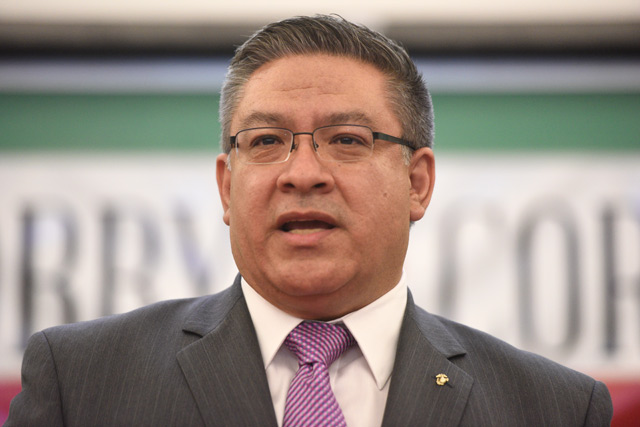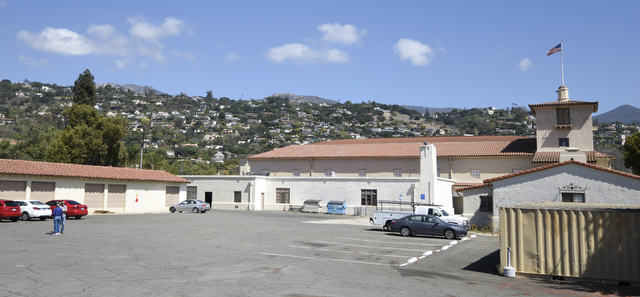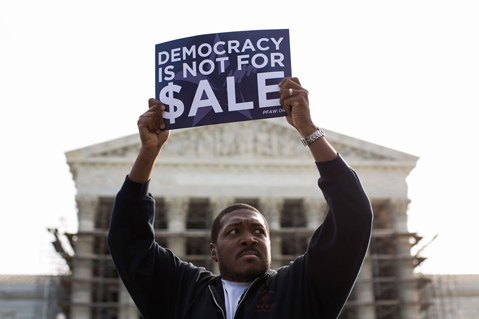2016 Election Endorsements, Part One
From President to Props, Our Picks for the 2016 Election

Here is the first installment of The Independent’s 2016 Election Endorsements. Over the next week we will be publishing endorsements for other races both online and in print. As always, we urge you to vote, whether you agree with us or not. To give access to the polls for individuals with disabilities and frail seniors, Easy Lift will provide accessible transportation; call (805) 681-1181 before November 7 to make a reservation.
President: Hillary Clinton
Never before has the choice confronting American voters been so perilous. On paper, the outcome should seem obvious. In Hillary Clinton, we have one of the most supremely qualified and thoroughly prepared candidates ever to run for the nation’s highest public office. She served as secretary of state, New York’s senator, and First Lady. By contrast, we have in Donald Trump a candidate whose life history betrays no pretense at public service and whose private accomplishments were achieved chiefly by fraud, deceit, and white-collared thuggery. For reasons both real and exaggerated, however, we recognize some of our readers are less than enamored of Clinton. Whatever your misgivings, think of all the human suffering that will unfold if Trump — an explosive genius for self-idolatry and hate — becomes the most powerful man in the world. And this could truly happen. Believe it.
We understand that Hillary Clinton, with her long history in the public eye, leaves a record that is not perfect. She has made mistakes. But such considerations should not obscure essential realities. In Hillary Clinton we have a time-tested, seasoned political leader of phenomenal strength and determination who has relentlessly pushed to expand the protective touch of health care. She has been an unwavering champion for women’s equality and reproductive rights. And from her earliest years she has worked to expand civil rights for all. Contrary to popular political folklore, these struggles for human equality are not “settled” but remain vulnerable and incomplete.
In the Democratic primary, Senator Bernie Sanders succeeded in improving some of Secretary Clinton’s ideas for reform. Let’s not disregard this. As an inveterate policy wonk, a quick study, and moderate pragmatist, Clinton’s already put forward detailed plans to increase child care for working families and the desperately needed student-loan reforms to shield those who would otherwise be shackled by burdensome debt.
Whoever wins this election will pick at least two new Supreme Court justices, thus defining fundamental legal and human values for decades to come. Given the depressingly retrograde rulings dispensed by the court majority prior to the death of Antonin Scalia, this is a historic opportunity — it cannot be squandered. The consequences of a Supreme Court defined by the likes of Donald Trump simply beggar the imagination.
Over the past years, the nation as a whole has been forced to confront anew the profound chasm of racial mistrust. After 30 years of destructive, unjust, and economically unsustainable law-and-order policies, the pendulum is finally swinging the other direction. To an uncommon degree, Clinton gets it. She will use the authority of office to pursue new paradigms for community policing. By contrast, Trump has systematically availed himself of the code speak of racial hate.
Trump’s outrages are too numerous to list. By now the whole world knows most of them: his attacks on Mexican immigrants, his promises to marginalize all Muslims, his idiotic idea to build a wall, his nakedly racist “birther” charge against President Barack Obama, his misogynistic attacks on women, and his refusal to repudiate the support of well-known white supremacists. These are not the comments of someone pushing back against the constraints of “political correctness.” These are the remarks of an amoral man who will do or say anything to gain attention and to hear the lusty cheers of his supporters. Consider his stunning remark that he would have had sex with his daughter were she not his daughter. How creepy and disturbing is that? And based on his performance at the first presidential debate, and his subsequent frantic tweeting against a beauty queen, we must seriously consider whether he is mentally competent to hold any public office.
Can we, the American voters, take a chance of unloosing such a person on the world? How much risk should we take just to shake up the political establishment? The community of nations, already volatile enough, can ill afford the violence and instability Trump would inflict. And neither can our country.
Above and beyond policy details and political rhetoric, this year’s presidential contest is fundamentally a referendum for the soul of a troubled nation. With Donald Trump, the choice is hate. With Hillary Clinton, the choice is hope.

Congress: Salud Carbajal
Experience counts and knowledge matters, but most important is performance. Judging by any of these standards, Salud Carbajal is by far the best and most obvious choice in the race for the 24th Congressional District.
For the past 12 years, Carbajal has served as 1st District county supervisor on the Santa Barbara board. For 12 years prior to that, he was an administrative assistant to his predecessor, Supervisor Naomi Schwartz. In this time, Carbajal — a moderate, liberal democrat — has matured, amassing such an exemplary record for constituent services that no candidate, from the left or right, has ever opposed him for his seat on the board. He is uncommonly accessible and knowledgeable about the issues. No one in the County Administration building works harder.
Most candidates nowadays promise to reach across the aisle. Few understand just how tough that can be. And even fewer have had any real, long-term experience doing it, especially in this new normal of partisan gridlock. Salud Carbajal is the exception. He has proved over and over that he possesses a rare ability to craft solutions to problems acceptable to both parties. One really toxic dispute that comes to mind was the battle over the Botanic Garden’s expansion plans. Through Carbajal’s efforts, an amicable solution was reached when none seemed possible.
Supervisor Carbajal, who attended UCSB, was the first in his family to graduate from a four-year college, served as a United States Marine, and has been a solid vote for coastal protection against oil development and for stronger air-quality standards in response to climate change. Less dramatic, but just as important, has been his inventive initiatives in mending the county’s fraying safety net. In one example, he succeeded in getting the board to agree to use tobacco-tax money to pay for health insurance for uninsured children in the county. Carbajal supports strong immigration reform, not the disgraced bracero program of the last century, and is a strong advocate for gun-registration background checks.
Carbajal’s life trajectory infuses his political values. Born in Mexico, Carbajal immigrated to the United States with his family as a young boy — first to Arizona, where his father worked in the mines, and then to Oxnard, where the whole family worked in the fields. When still in Arizona, his older sister committed suicide. Carbajal, then in grade school, was in the next room. That experience seared in him an abiding interest in mental-health reform.<
By contrast, Carbajal’s opponent, Republican Justin Fareed, has had no meaningful experience in the district he presumes to represent. Fareed’s campaign apparently rests on two factors: He excelled in high school football, and he worked as a legislative assistant for 15 months with conservative Republican Kentucky congressmember Ed Whitfield, a recently disgraced politician strongly backed by the coal and pharmaceutical industries. How these experiences will do anything to help the rest of us living in the 24th Congressional District is anybody’s guess. We do know he has accepted large donations from murky sources, supports Donald Trump, and has a temperament with a low threshold for political disagreement. He is a local boy, however, with pleasant manners who grew up in Montecito, where his father is a highly respected surgeon and his mother is one of the region’s premier real estate agents. Until running for this office, he has worked for his parents’ successful medical-supply business. Perhaps in the years to come he will gain experience working in local elections and volunteering in the community. But he is definitely not ready for Washington, D.C.
Fareed promises he will bring a physical vigor and intensity to Congress with “fresh” ideas and “fresh” energy. But it’s not always clear just what he’s saying when he tries to explain his positions on issues. Nor is it clear why he should garner serious consideration given his complete lack of applicable experience. Fareed’s promises are too meager for our troubled times. They are in no way a substitute for experience, knowledge, and — above all — performance. Those are the qualities we find in Supervisor Salud Carbajal.

3rd District: Joan Hartmann
Of all the races in the County of Santa Barbara this November, the race for the 3rd Supervisorial District will have the most direct impact, even for people living outside district boundaries. The 3rd District, which encompasses everything from Guadalupe to Isla Vista, has traditionally carried the key decisive swing vote at the board of supervisors; which way blows the 3rd, blows the county.
In other words, it’s for all the marbles.
This year, the race pits two Santa Ynez Valley residents — Joan Hartmann and Bruce Porter — against one another. Both moved here about 15 years ago from places elsewhere; both are relative newcomers to the political scene, having lived full, productive, and impressive lives; and both jumped into local civic engagement about eight years ago. Of the two, we enthusiastically recommend Joan Hartmann. Her history of civic involvement, environmental knowledge, and measure-twice-cut-once temperament equip her to respond creatively and effectively to the challenges confronting county government. We’re confident Hartmann can mesh well into a new moderate, environmentally minded board majority on the county supervisors along with three-term Supervisor Janet Wolf and supervisorial newcomer Das Williams. While Hartmann is notably more soft-spoken than these other two, she’s nobody’s pushover and will not be overwhelmed by either their vehemence or volume.
Before moving to the valley, Hartmann taught public policy and environmental studies at Oberlin College and Claremont Graduate University. She worked a stint with the Environmental Protection Agency before focusing on wetlands recovery, an important issue in Santa Barbara. For three years, Hartmann served on the County Planning Commission, where she impressed observers with not just how hard she prepared but how precisely — and with such little grandstanding — she posed questions.
On the issues, we know Hartmann will leave few stones unearthed to protect the Gaviota Coast, keeping it one of the most ridiculously beautiful spots on the planet. She’s already conversant with the key parts of development proposals, ownership histories, and growth management options. Even before she was a commissioner, she led the 2008 charge to limit growth and development sprawl outside the Buellton urban limits.
Her opponent, Bruce Porter, is less specific about preserving the Gaviota Coast and definitely less informed about development issues. That’s understandable, given that he wasn’t a planning commissioner, but concerning nonetheless. Of more concern, Porter is backed by individuals who fought Hartmann’s growth-containment initiative in 2008.
On the issue of oil development, the candidates pose stark differences. Hartmann’s threshold of safety for any new oil facility would be exceptionally rigorous. Hartmann has expressed grave concern throughout the campaign about the risks from steam-injection technologies on subsurface water supplies. As county planner, she voted for tougher standards on air-quality emissions allowed by new onshore oil developments.
By contrast, a political action committee created by oil companies to get Porter elected has raised $60,000 on Porter’s behalf. Porter has insisted that oil produced under Santa Barbara’s strict environmental regulations is more socially responsible than imported oil from nations without such regulations. Also troubling is his campaign’s efforts to limit UCSB students from registering to vote.
We know Hartmann wants the job. We also know she’ll work like a fiend once she gets it. And we believe she’ll figure out a way to work well with her fellow supervisors — even those on the other side — once she’s there. We urge a vote for Joan Hartmann.

Goleta City Council: Stuart Kasdin and Kyle Richards
New growth and development have exploded throughout the Goleta Valley in the past six years in no time since the 1970s, and residents — accustomed to the politics of cruise control — are now grabbing for the wheel. “What happened to the mountain views? Aren’t we in a drought? Where’s the water coming from?” These are all very good questions. The Santa Barbara Independent always worried that cityhood would accelerate the impetus for growth; the easiest way to provide basic services is to generate revenue through development. It’s called zoning for dollars. This tendency was greatly exacerbated by the horrible financial deal Goleta city founders made with Santa Barbara County in order to gain cityhood. That may all be water under the bridge, but when there’s nothing left in the dam, it’s cause for serious pause. The two candidates pushing the pause button hardest are Stuart Kasdin and Kyle Richards, who we think would bring some necessary balance to a government body otherwise too quick to say yes to developers and too slow to impose conditions designed to protect the environment and ensure affordability. Kasdin and Richards bring years of knowledge and engagement, not to mention professional and governmental chops that would vastly expand and improve the scope of public discussion.
Measures E and F (New Community Services District for Isla Vista) • Yes and Yes
Very little of the neglect visited upon Isla Vista by the powers that be over the past 40 years can be remotely construed as benign. That’s why we support Measures E and F, which would create a new community services district for Isla Vista and endow it with an operating budget of half a million bucks. This may lack the rhetorical flourish — and political punch — of actual cityhood, but it’s a necessary step in the direction of local control. When 23,000 people find themselves crammed into overpopulated, overpriced, and conspicuously under-maintained rental units — all shoehorned into a one-square mile — some vehicle for self-determination is crucial. County government is not designed to handle such intensely urban needs, and the Isla Vista Recreation & Park District — despite heroic efforts — is not constituted to fill the breach. We don’t pretend the creation of this new district will tame Isla Vista’s wild spirit, nor would we want it to. Many of the 23,000 are, after all, young adults living away from home for the first time; steam needs to be vent. But many are confronting grueling academic, economic, and social pressures, and something more tangible than good intentions is needed to ensure that limited public resources are put where Isla Vista most needs them. When well-meaning bureaucrats — either county planners or UCSB administrators — concoct some cure for what they think ails Isla Vista, Isla Vistans need a microphone to speak their own truths. Measures E and F do just that. The funding, we should stress, is both exceedingly modest and equitable. Revenues are derived from a surcharge on utility bills, meaning everyone pays a tiny stipend — $5-$10 a month — not just property owners. Technically speaking, this is not a tax despite claims to the contrary by opponents. Lastly, if voters approve E and F, the university had pledged to kick in $200,000 a year for at least seven years. Admittedly, this is a paltry sum, but like Measures E and F, it’s a necessary start.
Measure D (Santa Barbara Marijuana Control Act) • Yes

Whether marijuana tax revenues become the yellow brick road to fiscal stability, as some of its advocates insist, has yet to be determined. But clearly there’s a lot of green to be made. The City of Santa Barbara already has a plan to allow up to three medical marijuana dispensaries. Measure D would tax the proceeds to the tune of 20 percent. Cigarettes, by comparison, are taxed at 52 percent per pack and booze at 27 percent per serving. Clearly, Measure D is aiming at the big bucks to be generated if and when recreational pot use — in the form of this year’s Proposition 64 — is legalized. With Measure D, the City of Santa Barbara can transition its new tax scheme to apply to whatever plan it adopts in response to Prop. 64. If approved, the City Council can lower the pot tax, but not raise it without additional voter approval. The revenues generated will ensure safe access for medical pot users and provide the resources for City Hall to respond to recreational pot legalization. Backing Measure D is a coalition of individuals who decidedly did not see eye to eye on medicinal marijuana dispensaries: Mayor Helene Schneider, Councilmember Randy Rowse, former school superintendent David Cash, and Parks and Rec Commissioner Lesley Wiscomb. If they can support Measure D, you should, too.

Measures I and J (Santa Barbara School Bond Measures) • Yes and Yes
As corny as it sounds, Measure I constitutes a once-in-a-lifetime opportunity for Santa Barbarans. It would set aside $20 million to purchase the 4.7-acre National Guard property located squarely in the middle of downtown Santa Barbara between the Santa Barbara high and junior high schools. This may not quite qualify as the Holy Grail, but it offers the school district and the whole community unprecedented possibilities for both indoor and outdoor recreational facilities. We get only one bite at this apple, so vote yes.
When the California Department of Defense agreed to sell a number of armories, State Assemblymember Das Williams scrambled fast and got Governor Jerry Brown to sign a bill giving S.B. Unified School District first dibs.
Measure I is a $135 million bond designed to provide infrastructure maintenance and upgrade funding for the district’s five junior high schools and four high schools — $20 million of which is for the armory. Whether that’s enough will depend on what the appraisers eventually determine. Likewise, it remains uncertain what kind of environmental time bombs — underground storage tanks, for example — might need to be remediated. If it costs more than the $20 million, then the school board will pass. Let’s hope that doesn’t happen.

Santa Barbara’s need for field space is growing. The armory itself contains a fabulous, if vintage, auditorium and basketball court. The outdoor acreage could be transformed into many new fields. The possibilities are truly endless, and the opportunities to squabble well nigh infinite. For us to get there, we need to approve Measure I. So do it.
And let’s not forget Measure J, which will help upgrade many of the dilapidated elementary schools. Maintaining the sprawling infrastructure of any urban-scaled school system is a bit like painting the San Francisco Bay Bridge; the work is never over, especially when you take into account the costs of building repairs and the high-tech needs of modern education. To this end, the Santa Barbara School District is asking for voters’ support for two school bonds — both I and J — which, combined, would raise $193 million in bond revenues to be used for addressing the physical plant needs for 22 campuses. That money would be paid back out via a bump in property taxes roughly equivalent to $25 for every $100,000 of assessed value. For a $1 million home, that’s an additional $250 a year in property taxes. And you can use the basketball court at the old armory.
Ballot Initiatives

Prop. 51 (School Bonds. Funding for K-12 School and Community College Facilities) • Yes
Prop. 51 authorizes the sale of $9 billion in bonds to build new schools and to maintain existing ones. Public schools face a staggering backlog of infrastructure needs, and the piggy bank is almost empty. Typically, these propositions are written by the legislature and governor; this one wasn’t. In fact Governor Jerry Brown has opposed it. Instead, it was written by a coalition of homebuilders and construction companies that already spent $10 million supporting it. It’s not perfect, but necessary.
Prop. 52 (Medi-Cal Hospital Fee Program) • Yes
In 2009, the state legislature crafted a tricky funding maneuver in which the state exacted money from California hospitals and used those proceeds to leverage double funding from the feds, funding that, in turn, is used to underwrite the treatment of low-income patients. Prop. 52 would indefinitely extend this big-ticket machination. Under the current formula, state hospitals — both public and private — will contribute $4.6 billion. In exchange, the feds will make available $8.1 billion. Even with the inflated fees charged by hospitals, that’s a lot of poor people served.

Prop. 53 (Statewide Approval for Revenue Bonds over $2 Billion) • No
Prop. 53 would require voter approval for the sale of any state-issued revenue bonds in excess of $2 billion. The elephant hiding under the carpet of this good-government measure is Governor Jerry Brown’s massively ambitious twin tunnels project to transport Northern California river water into cavernous tunnels underneath the Bay Delta and onto the parched consumers of the south. No one knows how much this project will cost, but it will be massive. Water agencies that tap into the State Water Project will be on the hook but will have no vote. Yet though we share the concerns of Central Valley farmer Dean Cortopassi, who put Prop. 53 on the ballot, we think that California’s infrastructure needs are so gargantuan that it’s not smart to hobble the procurement process now. Ballot-box budgeting, while sometimes necessary, always has unexpected repercussions.
Prop. 54 (Legislature. Legislation and Proceedings Initiative) • Yes
This qualifies as one of the rare good-government reforms that make tons of sense. Prop. 54 amends the state constitution to require all bills that are to be voted on by the entire legislature to be published at least 72 hours in advance. Many bills are drastically amended seconds prior to a vote. Prop. 54 would prevent this practice. In addition, Prop. 54 requires all legislative meetings be recorded, posted on the Internet, and saved for 20 years. This bill is the brainchild of Republican rainmaker Charles Munger Jr. — who has spent $10 million to get it passed — so naturally, the Democratic Party and the California Labor Federation oppose it. But vote yes anyway.
Prop. 55 (Tax Extension to Fund Education and Health Care) • Yes
In 2012, California voters approved Prop. 30 — at the behest of Governor Jerry Brown — which temporarily raised income taxes on state residents earning more than $250,000 a year to get California state government over the hump of the recession. That tax increase is slated to expire in 2018. Prop. 55 would extend that tax increase until 2030, capturing anywhere from $4 billion to $9 billion a year until then. Half of that would go to schools and community colleges, up to $2 billion a year to Medi-Cal funding, and up to $1.5 billion to pay off existing debt. As a political salve, the sales-tax increase that had been included in Prop. 30 will not be extended, so sales taxes should drop by a quarter percent at the year’s end. If Prop. 55 does not pass, the state legislature will have to cut school and health-program budgets by billions of dollars. In this context, Prop. 55 might not be the ideal way to run a railroad, but it will keep state finances on track.

Prop. 56 (Cigarette Tax to Fund Health Care, Tobacco Use Prevention, Research, and Law Enforcement) • Yes
If passed, Prop. 56 would tax every pack of cigarettes sold in California by $2 more. It’s estimated that will generate up to $1.4 billion more a year, to finance health care, cancer research, and smoking prevention. The cigarette industry has already raised $56 million to argue this tax is objectionably regressive. Really? Smoking contributes to 40,000 deaths a year in California alone. Other states charge as much as a $4.35 tax per pack. Currently, California’s tax is only 87 cents. That’s so low that the state is all but subsidizing smoking. This is a no-brainer.

Prop. 57 (Criminal Sentences. Parole. Juvenile Criminal Proceedings and Sentencing) • Yes
Governor Jerry Brown is spending millions of the campaign funds he raised in previous years to make sure Prop. 57 passes, and for good reason. Brown is hoping to undo — on his way out the door — some of the damage he inflicted during his first stint as governor 40 years ago when he embraced many of the get-tough-on-crime measures that made California’s prisons system so dangerously overcrowded. Currently, county district attorneys get to decide whether to charge juveniles as adults. Prop. 57 would let juvenile court judges determine that. Also, the measure will give nonviolent offenders in state prison an opportunity to earn time off for good behavior. This doesn’t guarantee anybody gets out, just that they have the opportunity to earn it. This would affect more than 30,000 inmates already in state prison and an additional 7,500 entering state facilities each year. Prop. 57, we are confident, would enhance the quality of justice now dispensed throughout California’s criminal justice system.

Prop. 58 (English Proficiency. Multilingual Education) • Yes
In 1998, California all but banned bilingual education, requiring that the state’s large population of English-language learners be taught primarily in English. Deviations from this approach were allowed, but only after individual proposals navigated a convoluted series of hoops at the statewide level. This measure recognizes that this one-size-fits-all approach may not be best suited for all 1.4 million English-language learners — 22 percent of the total student population — now attending California public schools. Prop. 58 would foster more flexibility by returning authority to approve individual innovative efforts — such as the dual-language approach offered at Adelante Charter School — to the local level. That’s where it should be. Vote yes on 58.

Prop. 59 (Corporations. Political Spending. Federal Constitutional Protections) • Yes
For those outraged when the Supreme Court allowed corporations — and labor unions — to give as much money as they wanted to political campaigns under the guise of constitutionally protected free speech in the now infamous Citizens United v. Federal Election Commission ruling of 2010, Prop. 59 is the perfect feel-good-do-nothing antidote. If passed, Prop. 59 will urge California elected officials to use their authority to amend the constitution to overturn Citizens United. Clearly, the impact of Citizens United — and all the PACs and super PACs it begat — has been deleterious in the extreme. But other than letting off steam, it’s fanciful to imagine Prop. 59 having any effect. To get change, we recommend voting for Hillary Clinton, who has made clear she will nominate to the Supreme Court only jurists opposed to Citizens United. In the meantime, vote for Prop. 59.
Prop. 60 (Adult Films. Condoms. Health Requirements) • Yes
Really, it’s come to this, a ballot initiative on regulating whether porn actors must wear condoms? The answer, obviously, is yes. Prop. 60 is on the ballot because the porn industry fled Los Angeles County when the supervisors there enacted a condom requirement on porn performers for health and safety reasons. Those health concerns are real. The porn industry says its customers, who spend $9 billion yearly on their products, don’t like condoms. By making this requirement statewide, Prop. 60 puts the porn industry on notice that there’s no place to hide — at least in California.

Prop. 61 (State Prescription Drug Purchases. Pricing Standards) • Yes
Prop. 61 illustrates yet again that for the big pharmaceutical companies, there’s no low to which they will not stoop to protect income stream. To date, the industry has contributed $90 million to stop a measure that will have, at most, a modest impact on its bottom line. Prop. 61, pushed by the AIDS Healthcare Foundation, would not allow any California state agency to pay more for prescription drugs than the lowest price paid by the Department of Veterans Affairs. How much this will save state agencies is hard to say. For those buying prescription medications via private insurance plans, the measure will have no direct impact. Normally, we don’t endorse initiatives based on the organizations opposing them. In this case, however, we think an exception needs to be made for the pharmaceutical industry, with its history of price gouging.

Prop. 62 (Death Penalty) • Yes Prop. 66 (Death Penalty. Procedures) • No
This is tricky, so pay close attention. There are two initiatives on the ballot that would drastically change the way the death penalty is carried out in California. The first one — Prop. 62 — would abolish capital punishment entirely. Anyone sentenced to death in the past or convicted of a capital crime in the future would be sentenced to life without the possibility of parole. The other one — Prop. 66 — would shorten the appeals process, increasing the likelihood of wrongful executions. We strongly support Prop. 62 — which would repeal the death penalty — and oppose Prop. 66 — which would accelerate it. Capital punishment serves no deterrent value. It takes around 25 years, at least, before anyone sentenced to death is executed. Since 1978, only 13 inmates have been executed at a cost of about $380 million each. Speeding things up by reducing the time for appeal, however, is a false solution; it increases the odds that the factually innocent or wrongly convicted will be executed.

Prop. 63 (Firearms. Ammunition Sales) • Yes
We firmly believe in the Second Amendment and the right to bear arms. The Second Amendment doesn’t say anything, however, about the unrestricted right to buy firearms capable of shooting 120 rounds a minute or ammunition clips capable of holding off a small militia. California already requires background checks for people buying guns; Prop. 63, written by Lt. Governor Gavin Newsom, will require the same for people buying ammo. It also bans outright the sale of large-capacity ammunition clips — the clips that allowed the tragedies at Sandy Hook, Columbine, San Bernardino, and so many more. And when a state with 39 million people makes a bold, powerful political statement like Prop. 63, a strong message is sent to other states where the elected officials might not be nearly so bold or powerful when it comes to gun violence.

Prop. 64 (Marijuana Legalization) • Yes
The fact is pot makes most people more boring than they already are, but that doesn’t mean they should be locked up for using it. Sanity, it appears, is at last on the horizon. Four states have already legalized the recreational use of pot, and this November, California and eight other states are looking to do the same. Under Prop. 64, adults 21 years and older would be allowed to grow six plants at home and possess up to an ounce. How that pot gets into the hands of customers will be up to cities and counties to determine, regulate, and tax. Statewide, it’s estimated Prop. 64 will generate $1 billion a year in tax revenues alone. In the meantime, the state is passing strict regulations as to how pot must be cultivated and transported. Prop. 64 leaves unresolved the thorny question of federal laws, which idiotically equate marijuana with dangerous drugs such as heroin. If a state as large as California joins the fray, sanity might finally arrive in Washington, D.C. Send a strong message; vote yes.
Prop. 65 (Carryout Bags. Charges.) • No
Prop. 67 (Ban On Single-Use Plastic Bags Referendum) • Yes

Both these measures are on the ballot thanks to the plastic bag industry and their lobby. Predictably, they’re crafty and confusing. Two years ago, Governor Jerry Brown signed a law banning single-use plastic statewide unifying the 122 ordinances passed by California cities and counties. One city was Santa Barbara. The planet may not have been saved overnight, but people did show they could and would change their personal habits and that greater environmental virtues existed beyond the short-term convenience of shoppers. The statewide ban signed by Brown needs to be ratified by the voters in the form of Prop. 67, and we strongly urge you to do so. Truly, it’s the least we can do.
Prop. 65 is a thinly disguised effort by the plastic bag industry to exact revenge on the grocery lobby for supporting the plastic bag ban in the first place. If passed, Prop. 65 would take the 10 cents per bag supermarkets are allowed to charge customers for paper bags and give these funds to undesignated environmental groups. The plastic bag lobby argues the revenues collected from paper bag sales constitutes a $300 million hidden tax. Those funds, the bag lobby argues, should rightfully go to groups fighting to clean up the environment. It’s worth noting that no major environmental organization has endorsed Prop. 65 and for good reason. The plastic bag lobby has never cared about cleaning up the environment.



